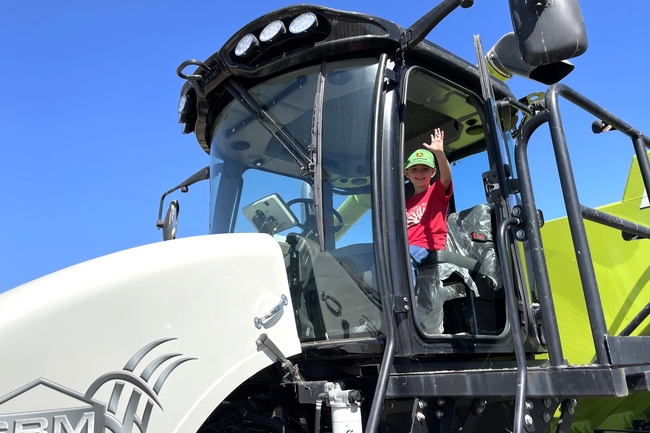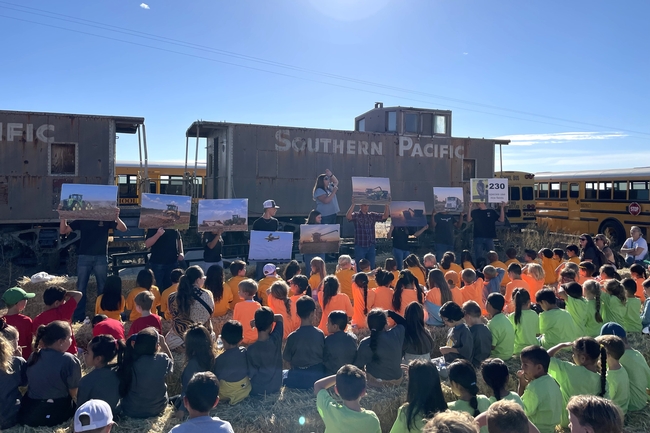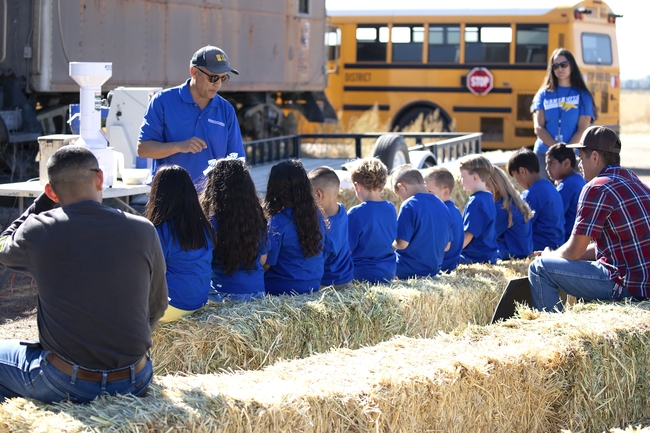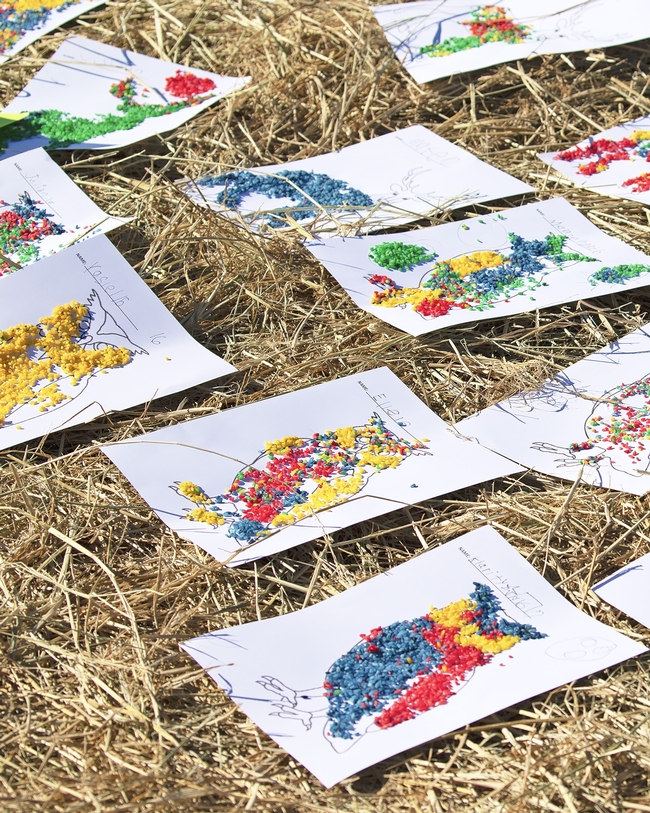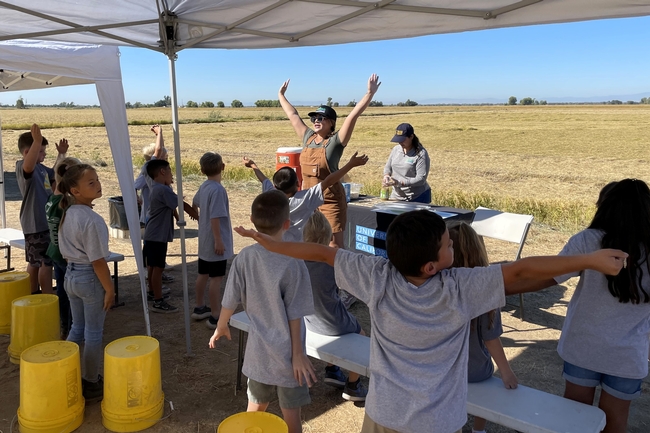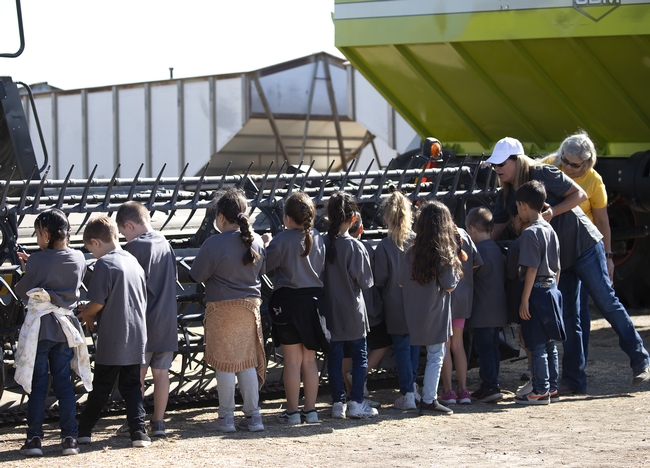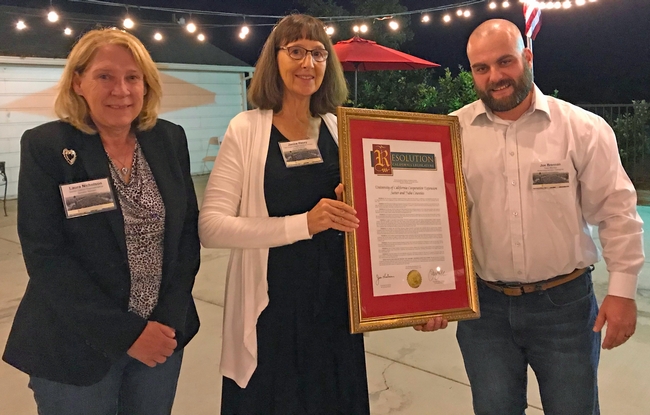
Posts Tagged: Sutter
Butte County first graders enjoy ‘ricetastic’ day at local farm
UC Cooperative Extension advisors, educators join growers in showcasing rice production
When Tracy Schohr volunteered in her son's pre-K class a couple years ago, she was stunned to find out that only two of the 20 children had ever been around a tractor. And this was in the rural Butte County community of Gridley, in the heart of California's rice-growing region.
Seeking to introduce more young children to agriculture, Schohr – the University of California Cooperative Extension livestock and natural resources advisor for the area – and her friend Lisa Donati created an event to showcase rice farming.
After the debut of “Ricetastic Day” last year with about 140 students from Gridley in attendance, this year's event on Sept. 19 attracted more than 240 schoolchildren – this time from across south Butte County.
First graders from McKinley Primary School in Gridley, Manzanita Elementary School, Biggs Elementary School and Richvale Elementary School – along with their teachers and many family members – enjoyed hands-on experiences at Schohr's rice and cattle ranch.
“There's a dwindling population that produces the food that we eat across America, so how can we have more people know, appreciate and love agriculture if we don't give them that opportunity?” said Schohr. “That's what this day is really about – to teach them about rice, to teach them about their community, how healthy rice can be, and how the farming and ranching can also create habitat for wildlife. It's all-encompassing.”
Event stations share different aspects of rice
Schohr, who grew up on the family ranch in Gridley, remembers coming with her McKinley schoolmates for a visit. But those field trips had comprised only lunch and a quick “drive-through” tour of the historic farming operation.
For Ricetastic Day, however, Schohr organized – with generous help from local growers and community partners – a more comprehensive half-day of activities. After her brother, Ryan Schohr, welcomed the participants to the family farm, the students formed groups that were led by Gridley FFA youth on a rotation through a variety of stations.
At the milling station, Luis Espino, UCCE rice farming systems advisor, demonstrated how his mini mill machines remove the husks from rough rice to make brown rice, and then polish away the bran layer to make white rice. He had the children see and feel the difference as the rice moved through processing.
“I didn't even know brown rice existed!” exclaimed Elsie, a first grader at McKinley.
A native of Peru, Espino came to study agriculture through his lifelong fascination with biology and living things – and he said events like Ricetastic Day can inspire a similar passion in young people.
“It might spark their curiosity so that they might go into these areas of work in the future or have a career in agriculture, when they see that people do this for a living,” Espino said.
Ray Stogsdill, another McKinley school alumnus, returned to Gridley after college to pursue just such a career. A staff research associate in the lab of UC Davis professor Bruce Linquist, Stogsdill manages on-farm rice variety testing across the region. He volunteered to help Schohr with Ricetastic Day by talking about some of the heavy equipment and providing his perspective for the kids.
“They drive by the fields and they don't know what's out there,” he said. “This gives them a chance to know what they're driving by, so they can say, ‘We have rice here and this is how it works; this is how it grows.' It gives them an idea of what's going on around them.”
Where rice fits within a healthy diet was the focus for the CalFresh Healthy Living, UC Cooperative Extension team, comprising nutrition educators Sunshine Hawjj, Joanna Aguilar and Kenia Estrada, as well as community nutrition, health and food security advisor Veronica VanCleave-Hunt. They talked about how rice – like other grains in that vital food group – gives people energy, and then taught the students an energetic “ricetastic” movement activity.
“Because our program is part of UC Agriculture and Natural Resources, it's important to make the connection between where our food comes from and how it gets on our plate – especially with young kids, so that we can promote value for our local agriculture and our food systems,” VanCleave-Hunt explained.
Activities spark further conversations, learning about agriculture
With rice harvest late due to late planting in the spring, Eric Waterbury of Waterbury Farms was able to take some time to attend the event. Although his family has been growing rice for three generations, he said he appreciates opportunities for the broader community to see all aspects of his work – from the equipment to the processing.
“If the kids walk away from this with one thing, I hope it's that they realize every time they have a meal, somebody was out there working hard to provide that meal,” he said. “It wasn't just the person at the grocery store that provided it for them.”
Schohr added that Ricetastic Day was only possible through the support of the community. Butte County Farm Bureau and Natural Resources Conservation Service staff helped kids make art with colorful dyed rice; neighboring farmer Tinker Storm described how the harvester and “bankout” wagon work; and rice farmers Shelley Beck and Sue Orme read aloud “Daddy's Got Dirt: A California Rice Story,” a children's book written by a local rice grower.
With rice at the center of physical activities, arts and crafts, and science lessons for the day, the students learned a lot to take home.
“It's nice that the kids got these hands-on learning experiences,” said Ryan Schohr, “so they can go home tonight and, at the dinner table, talk about it with their parents or brothers and sisters, over dinner or over homework – and share what they learned here on the farm and about their community.”
Rebecca Christy, a first- and second-grade teacher at Biggs Elementary, said she is excited to return to the classroom and hear from her students about all that they learned during the day.
“Every morning right now I'm seeing the big trucks going by our school, and so I'll be able to point that out to them, ‘Where are they going? What are they doing?'” she said. “I can't wait to get back to school and let them tell me about all of this.”
One of her students, Ximena, was finishing her brownbag lunch as the group watched one of the Schohr Ranch harvesters rumble over the field. Despite enjoying a rice cake and a rice cracker earlier, she said her meal was missing one thing.
“Where is my rice, Miss Christy?” she said. “I want rice!”
UC Cooperative Extension in Sutter and Yuba counties celebrates 100 years
Sutter and Yuba counties' UC Cooperative Extension marked the centennial anniversary of the local offices this year, reported Chris Kaufman in the Appeal Democrat. Led by county director Janine Hasey, the now-merged UCCE office celebrated 100 years of continuous support to farmers, youth, families and communities in the area.
Sutter/Yuba UCCE's historical significance was amplified when Hasey discovered a cache of historical documents in the office. Jessica Hougen of the Sutter County Community Memorial Museum created a display highlighting the information, which debuted at the 100th anniversary event. The exhibit will be on display at the museum through mid-December.
With Hougen's assistance, the UCCE Sutter-Yuba staff wrote articles highlighting UCCE's contributions to the local agriculture industry for the counties' crop reports.
The 2017 Yuba County Crop Report outlines the history of UCCE in the county, starting with the hiring of William Harrison as Yuba County's first UCCE farm advisor on July 1, 1918, then listing a timeline of contributions that resulted in economic benefit to farmers and reduced impacts on the environment.
The 2017 Sutter County Crop and Livestock Report lists major contributions of UCCE to the county over the past 100 years, with a sidebar focusing on rice.
“Our partnership goes back to our first farm advisors, who were housed in the same buildings with the ag commissioners in each county,” Hasey said.
The Appeal Democrat article included a sidebar focusing on the career of David Ramos, who in 1959 took his first job out of college as an extension assistant in the Sutter County UCCE office.
“When I was there, our office was downstairs from the post office in Yuba City and it's incredible to see how it's changed,” said Ramos, 85, of Davis. “What's so incredible is the number one crop when I got there was cling peaches. It tickles me to see the transition because I've seen the prune and walnut industry develop since then and it gave me an incredible perspective on the dynamics of the change that's taken place.”
The reporter also highlighted the 4-H Youth Development program in his article with quotes from Nancy Perkins of Live Oaks, an active 4-H volunteer.
“My father and his siblings were in Franklin 4-H, and it was a way of life for them back in the 1930s,” she said. “My dad was part of 4-H, I was part of 4-H, my children were part of 4-H and my grandchildren are part of it.”
Yuba and Sutter County 4-H’ers Participate in MZAD Bio-security Research Project
Youth from 4-H programs in Yuba and Sutter counties participated in the recently-completed...
4-H members create Sutter County flag
Sutter County now has an official flag because of two Sutter County 4-H members, according to a story on Fox 40 News in Sacramento.
4-H'ers Francisco Ruiz and Franklin Tarke, both high school sophomores, were asked to bring along their county's flag for a presentation at a 4-H conference. That's when they learned Sutter County has never had a flag.
"People that had gone in the past had to either make a flag out of paper or not participate in the flag ceremony and we didn't really want to do that," said Tarke.
The duo designed three flags and conducted an online poll to select the 161-year-old county’s first flag. On Wednesday, the Sutter County Board of Supervisors proclaimed the 4-H'ers creation the county's official flag.
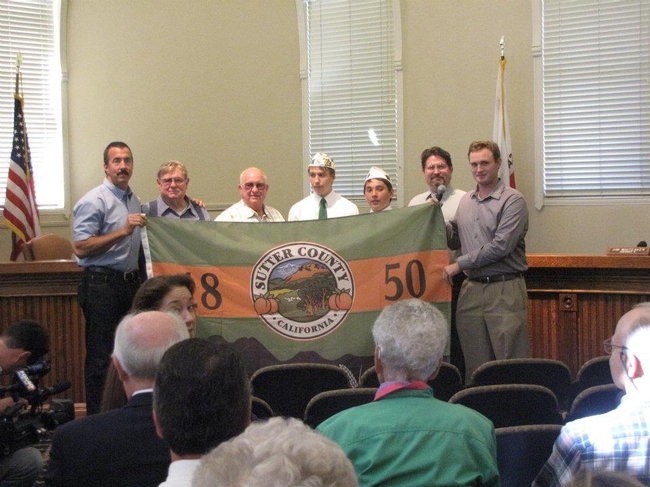
4-H members create Sutter County's first official flag.

